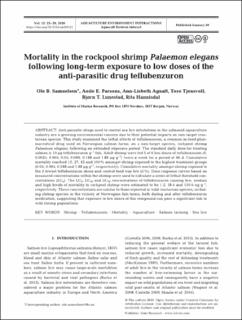| dc.description.abstract | Anti-parasitic drugs used to control sea lice infestations in the salmonid aquaculture industry are a growing environmental concern due to their potential impacts on non-target crustacean species. This study examined the lethal effects of teflubenzuron, a common in-feed pharmaceutical drug used on Norwegian salmon farms, on a non-target species, rockpool shrimp Palaemon elegans, following an extended exposure period. The standard daily dose for treating salmon is 10 µg teflubenzuron g-1 fish. Adult shrimp were fed 1 of 6 low doses of teflubenzuron (0, 0.0025, 0.005, 0.05, 0.094, 0.188 and 1.88 µg g-1) twice a week for a period of 66 d. Cumulative mortality reached 15, 27, 82 and 100% amongst shrimp exposed to the highest treatment groups (0.05, 0.094, 0.188 and 1.88 µg g-1, respectively). Cumulative mortality amongst shrimp exposed to the 2 lowest teflubenzuron doses and control feed was low (5%). Dose response curves based on measured concentrations within the shrimp were used to calculate a series of lethal threshold concentrations (LCx). The LC5, LC50 and LC90 concentrations of teflubenzuron causing low, median and high levels of mortality in rockpool shrimp were estimated to be 1.2, 18.4 and 150.6 ng g-1, respectively. These concentrations are similar to those reported in wild crustacean species, including shrimp species in the vicinity of Norwegian fish farms, both during and after teflubenzuron medication, suggesting that exposure to low doses of this compound can pose a significant risk to wild shrimp populations. | en_US |
